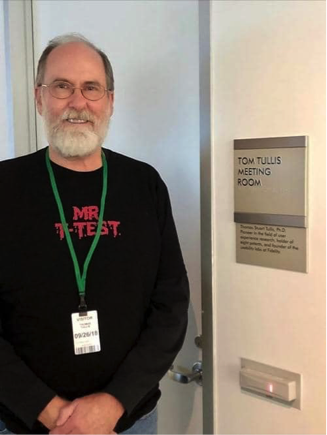[:en]

Dr. Thomas S. Tullis was born on April 16, 1952, in Memphis, Tennessee and died from complications of COVID-19 on April 29, 2020. He leaves behind his wife, Susan (Richardson) Tullis, and two adult children, Cheryl Tullis Sirois (along with her husband, Craig Ernest Sirois, Jr.) and Virginia Tullis. He is also remembered fondly by his brother, Kenneth Frank Tullis Sr., MD, his sister-in-law Madge (Wood) Tullis, his nephew Kenneth Frank Tullis, Jr., his nieces Meg (Tullis) Morris and Mary (Tullis) Barker, and his sister Kay (Tullis) Ledbetter.
Tom contributed 30+ years of experience in the field of human-computer interface studies, he has published more than 50 papers in numerous technical journals, and has been an invited speaker at national and international conferences. He also holds eight U.S. patents and was an Adjunct Professor at Bentley University. He was the 2011 recipient of the Lifetime Achievement Award from the Usability Professionals Association (now UXPA, 2012). He was also inducted into the CHI Academy of ACM SIGCHI.
Tom retired in 2017 from his position as Vice President of User Experience Research at Fidelity Investments. He joined Fidelity in 1993 and was instrumental in the development of the company’s user experience organization and state-of-the-art usability lab. Prior to joining Fidelity, Tom held positions at Canon Information Systems, McDonnell Douglas, Unisys Corporation, and Bell Laboratories. He and Fidelity’s usability team have been featured in a number of publications, including Newsweek, Business 2.0, Money, The Boston Globe, The Wall Street Journal, and The New York Times. Tom received a BA from Rice University, an MA in experimental psychology from New Mexico State University, and a PhD in engineering psychology from Rice University.
Tom exceled at bringing his strong engineering and human factors expertise into the everyday design of both digital and physical user experiences while at Fidelity Investments. His research interests varied from highly theoretical research to very applied research. One seminal paper explored the potential of using a user’s personal pictures as a means for authentication—something he called “pictorial passwords” (Tullis et al., 2011).
Another research focus Tom explored at Fidelity was in the field of web usability for older users. He and I (and our co-author Donna Tedesco) pondered whether the concept of web experience and web expertise were essentially the same thing, hypothesizing that how users learned the web (i.e., if users did not learn the web in their workplace) was more predictive of their expertise than simply their amount of web experience (2004).
Tom was also interested in researching very applied research in the field of web design. For example, he studied how to most effectively design two-state toggle buttons (Tullis et al., 2016).
Tom brought both intelligence and integrity to everything he did. Tom’s influence at Fidelity Investments was so significant that a room was named after him.

Tom Tullis was truly a mentor to thousands of colleagues in our International UX Community for decades. He also loved trivia (especially UX trivia), dad jokes, statistics, photography, genealogy, fixing old technology, teaching, Krispy Kreme, being a self-proclaimed geek, and mentoring those who were newly entering our industry. In addition, Tom was known for his generous spirit, his intrinsically kind nature, his modesty, and his incredible servant leadership.
At his surprise retirement party, which was also a UX trivia night, we made “WWTD (What Would Tom Do?)” bracelets. That is a question I still ask myself both in my work and personal life, because Tom was a person who graced us all by his presence in our lives. Tom was truly a pioneer in his work, publications, and academic endeavors. His many contributions in the UX industry will forever be influenced by his time among us.
Throughout his entire life, Tom had a passion for teaching and mentoring. Even as he managed a team of 50 at Fidelity Investments, he would always ask any intern to set up a regular 1:1 meeting with him. Tom set the standard at work that our interns were present to learn from us (rather than work for us), and he expected them to be integrated into all aspects of how we did our jobs. He was generous with his time and never said “no” if someone asked to meet with him. His international reputation brought excellent candidates to our team. But Tom was truly a servant leader. He saw his job as one that was meant to both serve and lead—and he demonstrated this by his actions. Our team believed that we all had contributions to offer, and we never really saw each other in any traditional hierarchical way. At Tom’s staff meeting, interns were given the same time and respect as anyone else on the team. Tom’s progressive thinking in terms of how to integrate interns into our actual work gave interns a truly valuable experience in their time at Fidelity and gave Fidelity and many other companies some of the most gifted, creative UX researchers in our industry today.
It is safe to assume that most major ecommerce/technology companies have at least one or more UX researchers/designers who either worked and/or learned from Tom Tullis. The impact he had on individuals and the companies for which they now work is impossible for us to measure (though, if Tom were still with us, he would be the first to find a way to statistically measure this). He left our industry forever changed and improved in only positive ways. One of the most seminal books in our industry, which he co-authored with William (Bill) Albert, is Measuring the User Experience (2013); this book has shaped how all UX researchers quantitively measure the usability of user experience designs. He also co-authored another influential book—Beyond the Usability Lab—with Bill Albert and Donna Tedesco (2010) that focused on how to conduct user research in ways that were beyond the usability labs. These books, along with his many publications and presentations, are part of the bedrock of the UX industry. Everyone who had the privilege to know Tom, walked away a better UX researcher/designer as a result.
To learn more about (and from) Tom and his professional legacy, please explore these resources:
- http://uxpaboston.org/in-memory-thomas-tullis-1952-2020/
- https://www.tribute.co/thomas-tullis
- http://uxpaboston.org/uxpa-board/tom-tullis/
- http://uxmetricsgeek.com/
- http://www.measuringux.com/TomTullis.htm
- http://hosting-6751.tributes.com/obituary/show/Thomas-S.-Tullis-108483838
- https://www.youtube.com/watch?v=Q9LExZOYpN8&t=16s
Side Note
As you think about Tom and his contributions to this world, I encourage you all to think about this: “How did Canada get its name?” (note: Tom absolutely loved and respected Canada). If you don’t know the punchline, ask just about anyone who knew him. I like to think that each time this exchange happens, Tom is laughing loudly (and proudly) from some incredibly good place in the geeky space-time continuum. After all, Tom also contributed to some design aspects of NASA’s International Space Station.
Acknowledgements
I would like to thank Tom’s family, friends, and colleagues who provided the essence of this article. Many thanks to the editors of this journal for their assistance and for allowing us the chance to provide this memorial of a truly “gentle” man who we will forever miss both personally and professionally.
References
Albert, W., Tullis, T., & Tedesco, D. (2010). Beyond the usability lab: Conducting large-scale online user experience studies (1st ed.). Morgan Kaufmann Publishers Inc.
ISBN-10: 0123748925, ISBN-13: 978-0123748928.
Chadwick-Dias, A., Tedesco, D., & Tullis, T. (2004). Older adults and web usability: Is web experience the same as web expertise? In CHI 2004 Conference on Human Factors in Computing Systems, Vienna, Austria.
Tullis, T., & Albert, W. (2013). Measuring the user experience: Collecting, analyzing, and presenting usability metrics (2nd ed.). Morgan Kaufmann Publishers Inc.
ISBN-10: 0124157815, ISBN-13: 978-0124157811.
Tullis, T., Baker, A., & LeDoux, L. (2016). What’s the most effective way to present two-state toggle buttons? [Poster Session]. User Experience Professionals Association 2016 Conference, Seattle, Washington, USA.
Tullis, T., Tedesco, D. P., & McCaffrey, K. E. (2011). Can users remember their pictorial passwords six years later? (pp. 1789–1794) In Proceedings of ACM CHI 2011 Conference on Human Factors in Computing Systems, Vancouver, BC, Canada.
[:]
